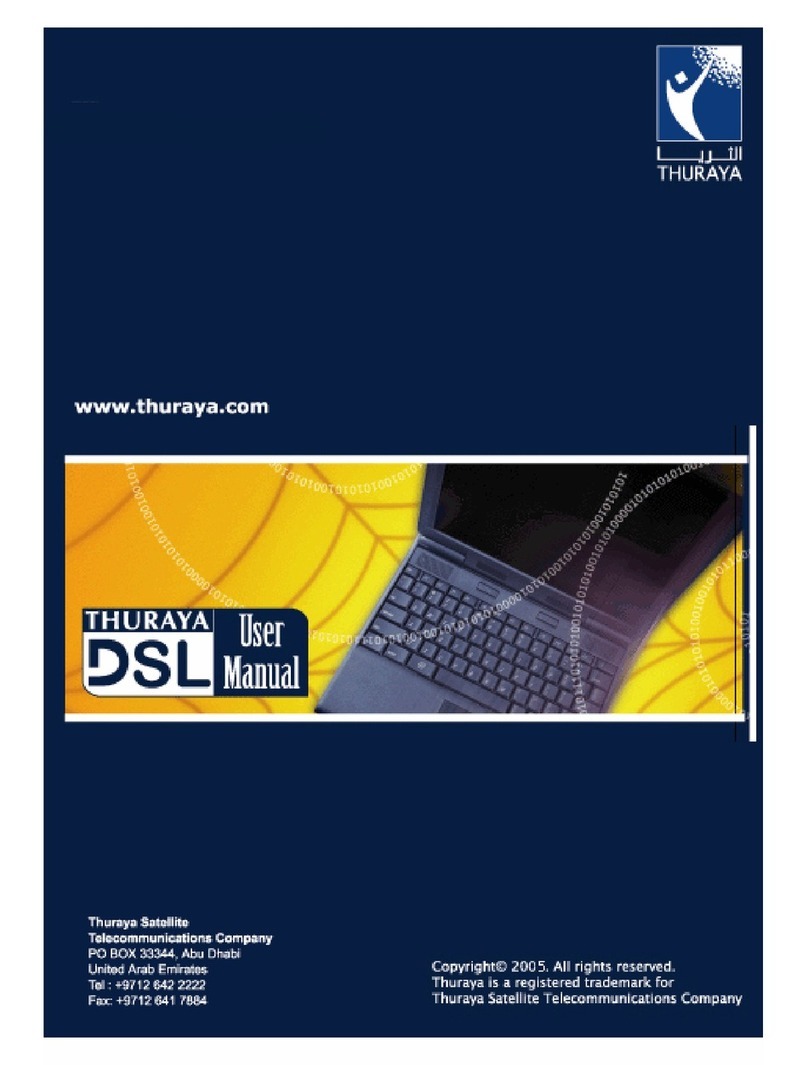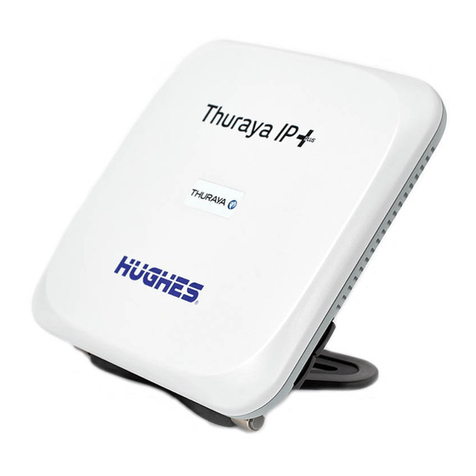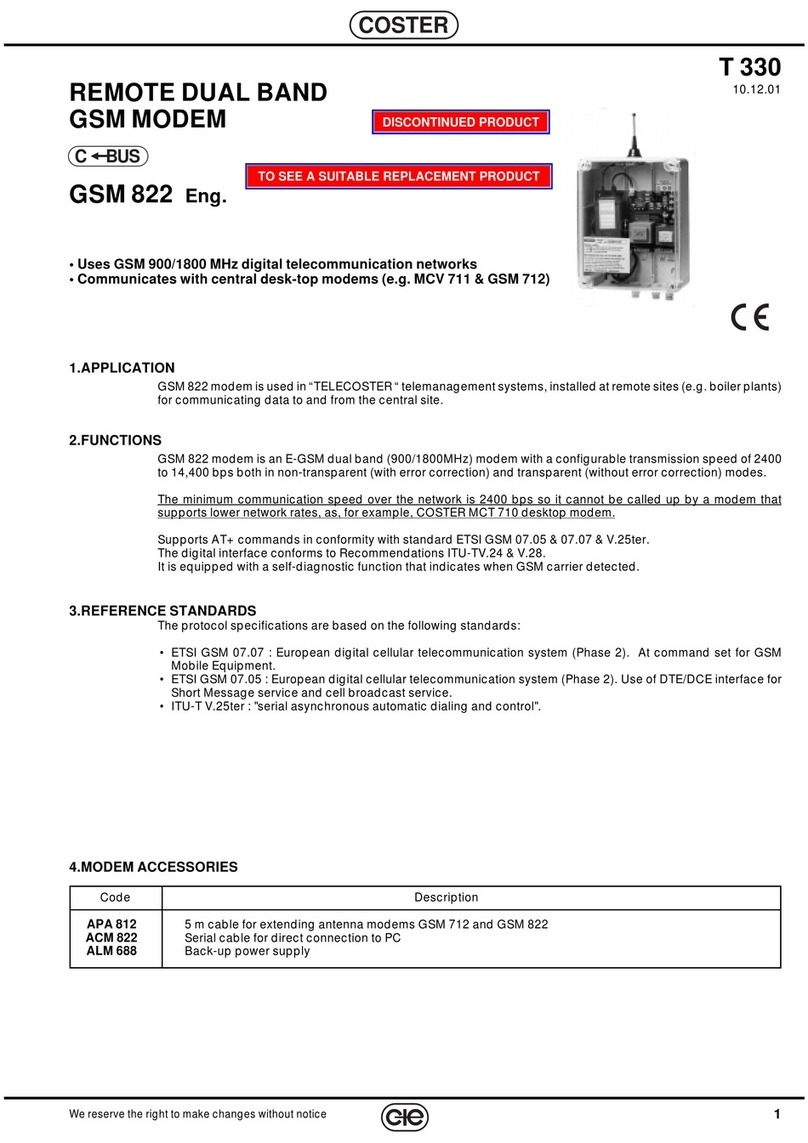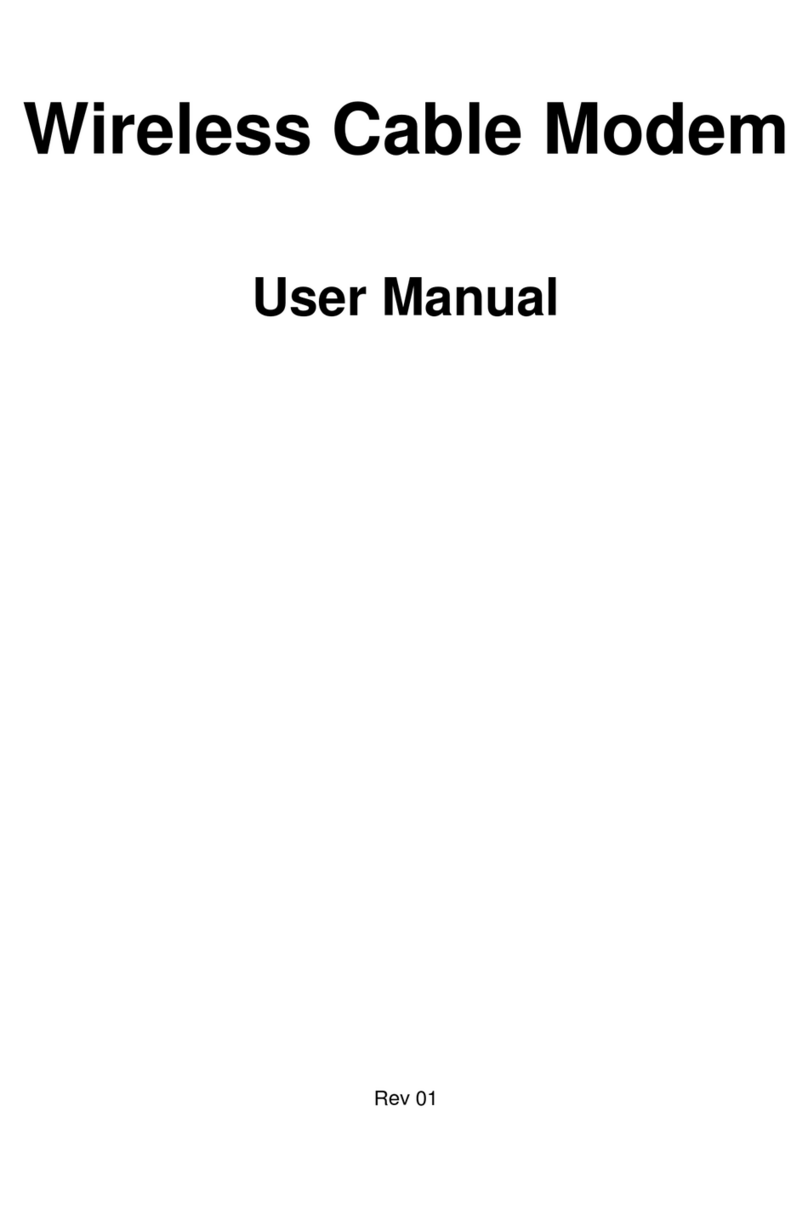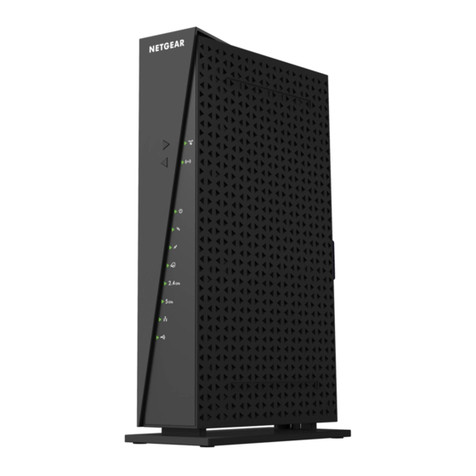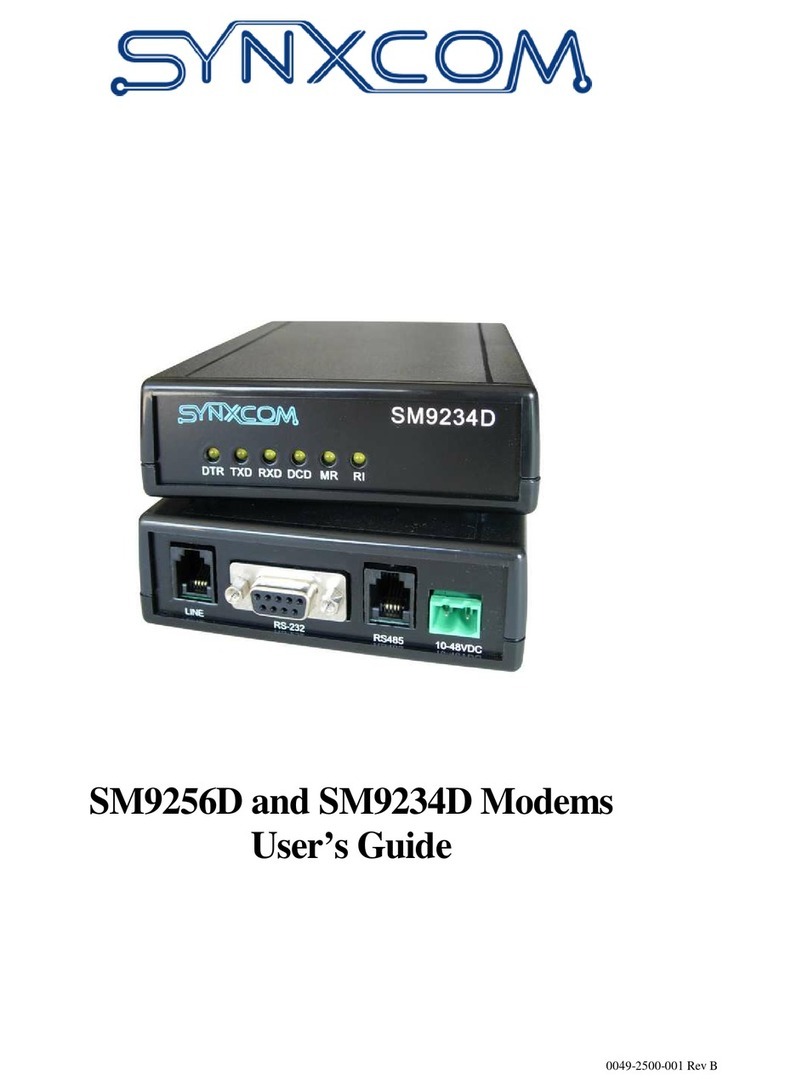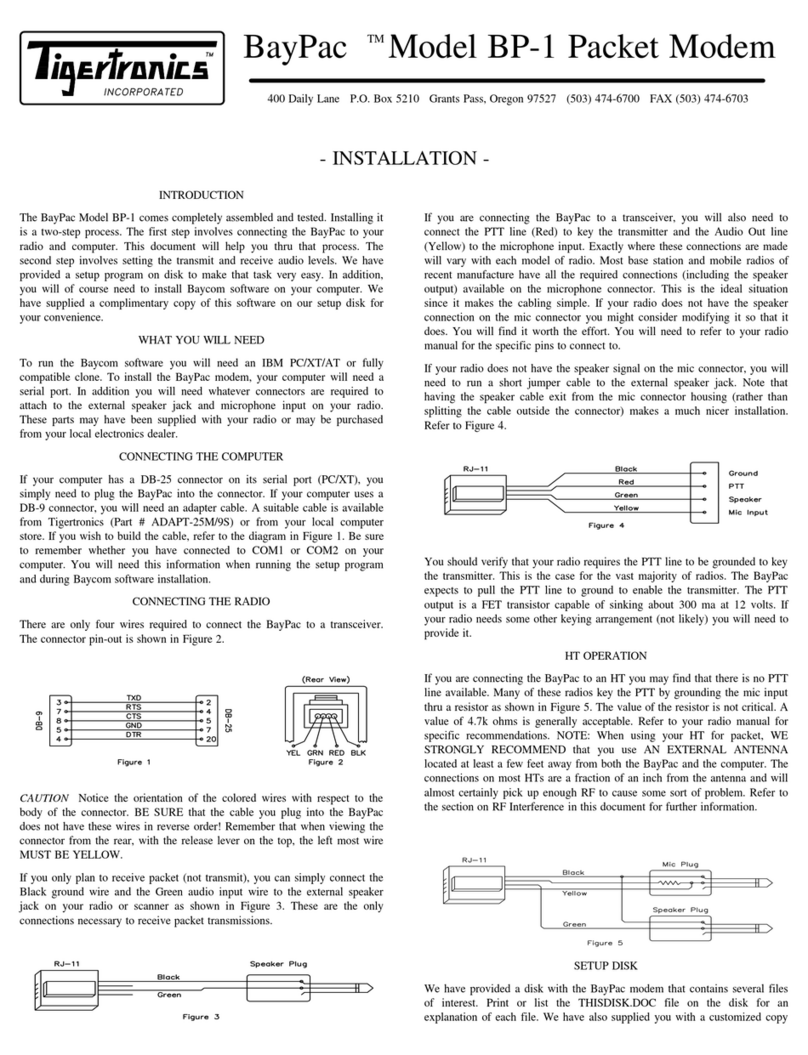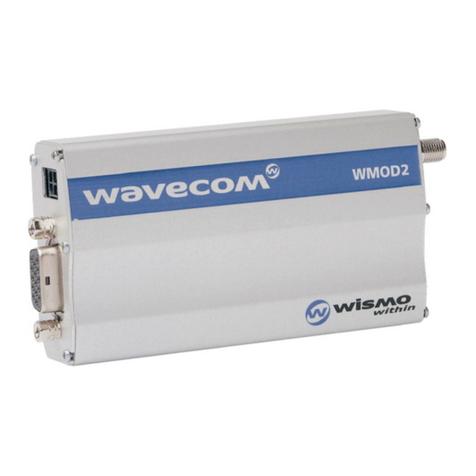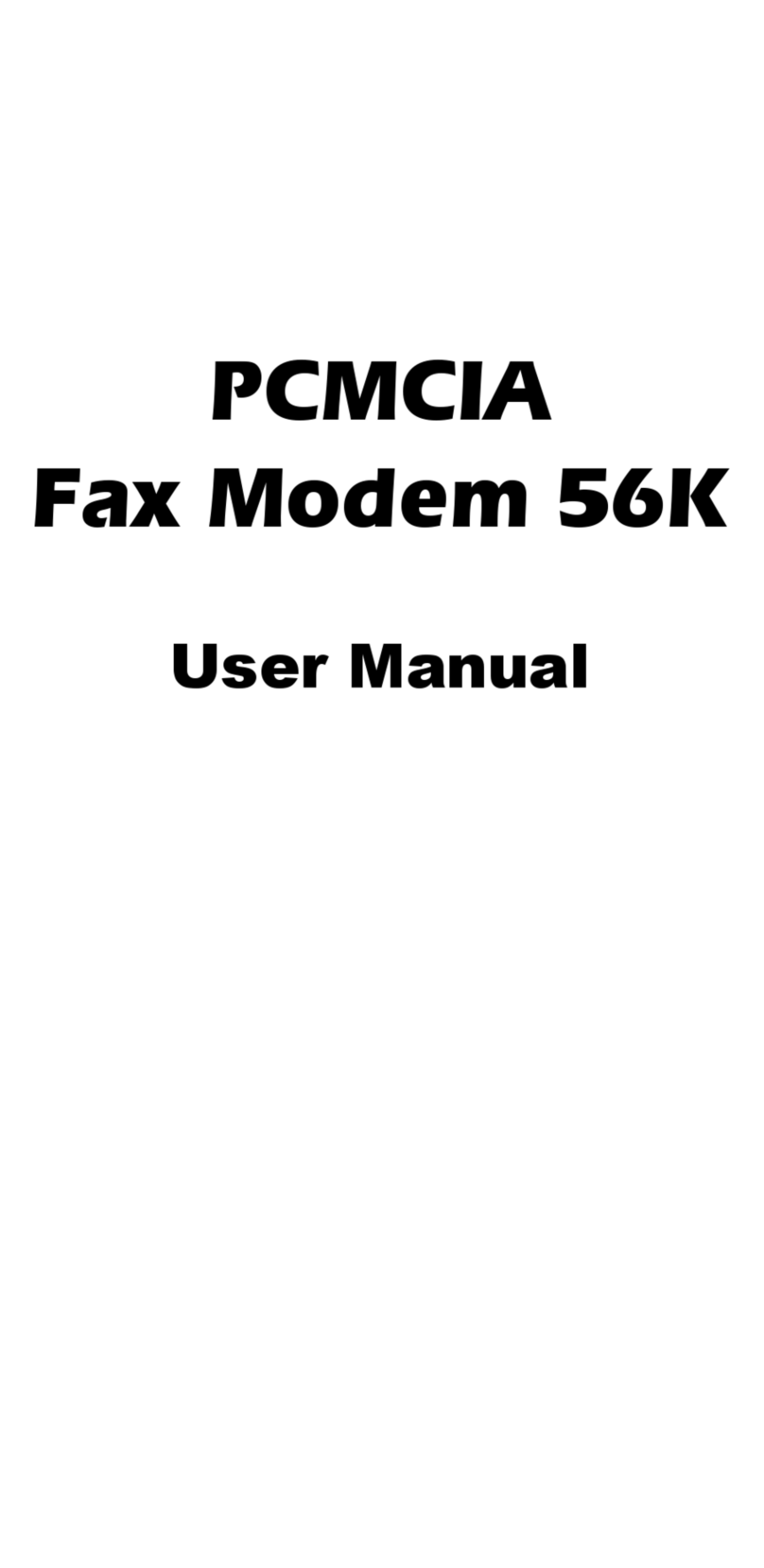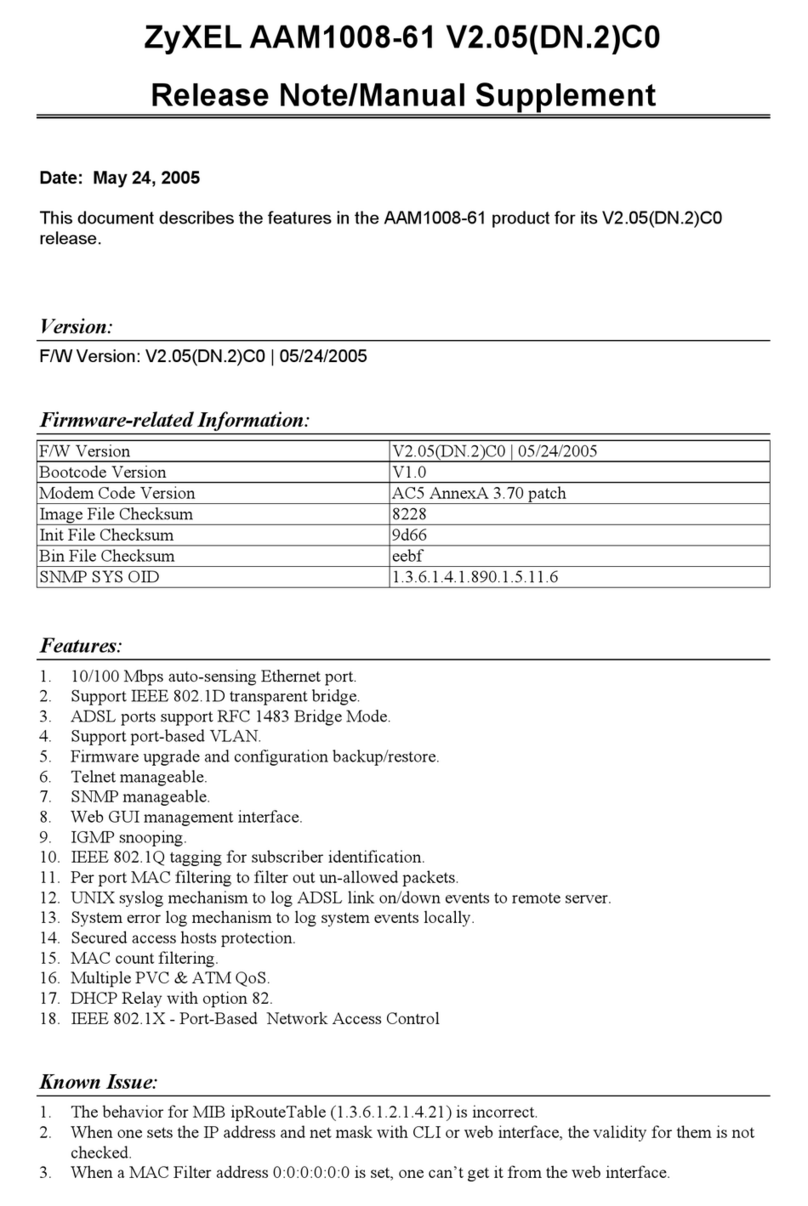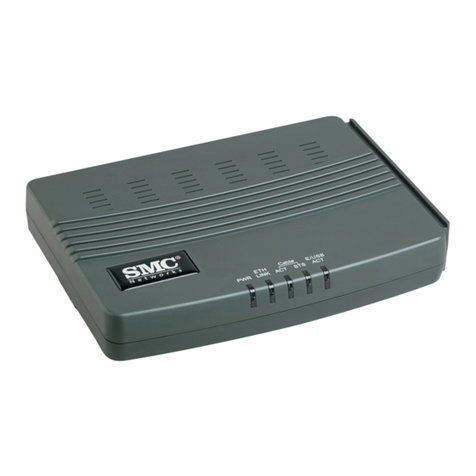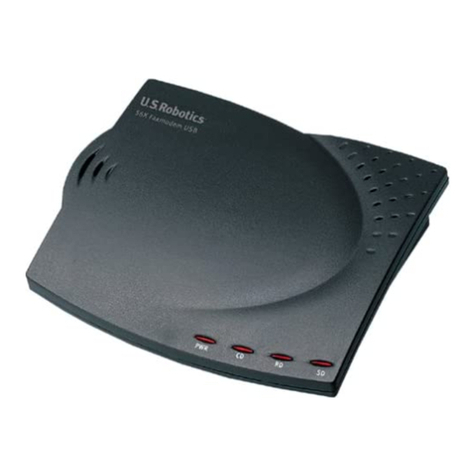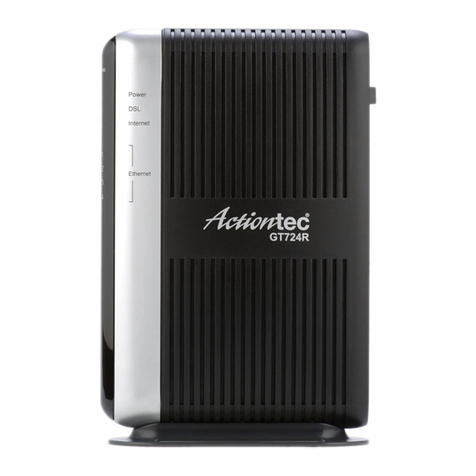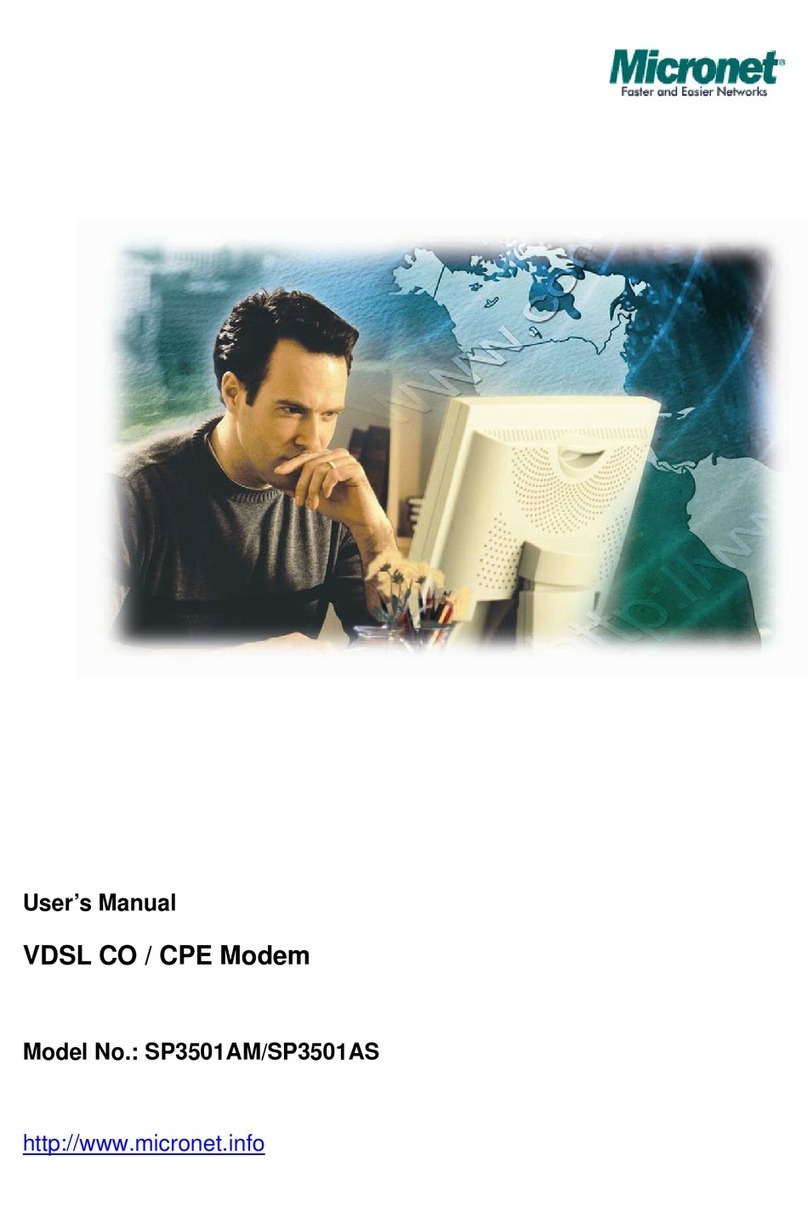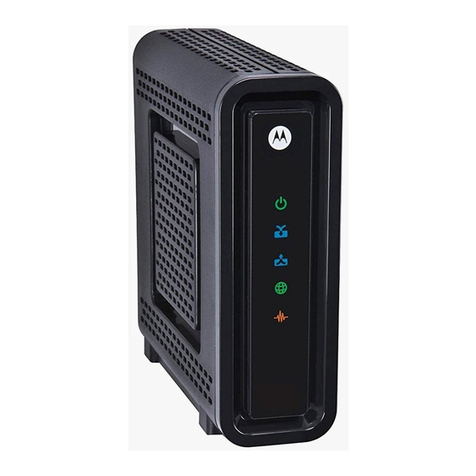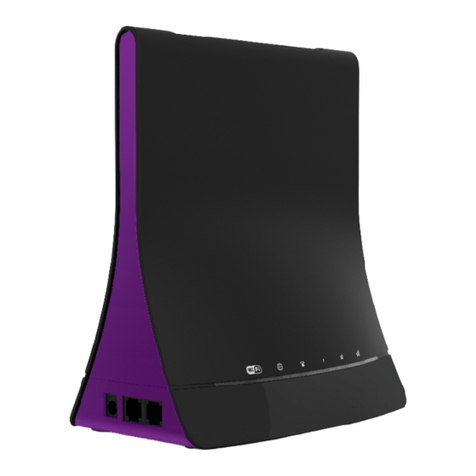Thuraya IP+ User manual

User Guide
ThurayaIP
Satellite Modem
Revision A.3
3500175-0001
PROPRIETARY NOTICE
All rights reserved. This publication and its contents are proprietary to Hughes
Network Systems, LLC. No part of this publication may be reproduced in any
form or by any means without the written permission of Hughes Network
Systems, LLC, 11717 Exploration Lane, Germantown, Maryland 20876.
HUGHES, HughesNet, IPoS, SPACEWAY, AIReach, Broadband Unbound,
and Connect to the future are trademarks of Hughes Network Systems,
LLC. All other trademarks are the property of their respective owners.
Copyright © 2013 Hughes Network Systems, LLC

ii
ThurayaIP Satellite Modem User Guide
Safety Information
For your safety and protection, read t is entire user guide before you
attempt to use ThurayaIP Satellite Modem. In particular, read t is
safety section carefully. Keep t is safety information w ere you can
refer to if necessary.
Warning Symbols Used in this Guide
T is section introduces t e various types of warnings used in t is
document to alert you to possible safety azards.
WARNING
Potential radio frequency (RF) azard. W ere you see t is
alert symbol and WARNING eading, strictly follow t e
warning instructions to avoid injury to eyes or ot er
personal injury.
WARNING
W ere you see t is alert symbol and WARNING eading,
strictly follow t e warning instructions to avoid personal
injury.
DANGER
Electric s ock azard: W ere you see t is alert symbol
and DANGER eading, strictly follow t e warning
instructions to avoid electric s ock injury or deat .

ThurayaIP Satellite Modem User Guide
iii
Warnings for THURA AIP
Do not stand in front of the Antenna
T is device emits radio frequency energy w en in t e transmit
mode. To avoid injury, do not place ead or ot er body parts
in front of t e satellite antenna w en system is operational.
Maintain a distance of one meter away from t e front of
ThurayaIP’s antenna.
Properly ground the Antenna
Failure to properly ground t e optional external antenna may
result in severe personal injury or deat . Do not attempt to
ground t e optional external antenna unless you ave t e skills
to do so in accordance wit local electrical codes.
Do not operate during Electrical Storms
Operation of ThurayaIP during electrical storms may result in
severe personal injury or deat . Disconnect ThurayaIP from
computer and store unit indoors if lig tning is anticipated in
t e area of operation.
General
Handle your ThurayaIP wit care. T e enclosure is weat er
resistant per IEC 60529 IP55. However, do not submerge t e
unit or expose it to severe rainstorms. Avoid exposing your
ThurayaIP to extreme ot or cold temperatures. T e operating
temperature range of ThurayaIP is -10ºC to +55ºC.
Avoid placing your ThurayaIP close to cigarettes, open flames
or any source of eat.
C anges or modifications to ThurayaIP not expressly approved
by Hug es Network Systems could void your aut ority to
operate t is equipment.
Use a soft damp clot only to clean your ThurayaIP.
To avoid impaired Modem performance, please ensure your
ThurayaIP’s antenna is not damaged or covered wit foreign
material like paint or labelling.
W en inserting t e SIM, do not bend t e SIM or damage t e
contacts in any way. W en connecting t e interface cables,
do not use excessive force.

iv
ThurayaIP Satellite Modem User Guide
In the vicinity of blasting work and in explosive environments
Never use ThurayaIP w ere blasting work is in progress.
Observe all restrictions and follow any regulations or rules.
Areas wit a potentially explosive environment are often, but
not always, clearly marked. Do not use ThurayaIP w ile at a
petrol filling station. Do not use near fuel or c emicals.
Qualified service
Do not attempt to disassemble your ThurayaIP. ThurayaIP
does not contain consumer-serviceable components. Only
qualified service personnel may install or repair equipment.
Batteries and accessories
Use approved batteries (HNS P/N 3500108-0001) and
accessories only. Use of non-approved accessories may result
in loss of performance, damage to ThurayaIP, fire, electric
s ock or injury.
AC Mains power adapter (HNS P/N 3500114-0001) is for indoor
use only. It as an indoor operating temperature range of -
10ºC to +55ºC and provides an output voltage of 12 VDC.
T e storage capability of t e battery decreases w en
operated below 0ºC. If t e battery is c arged at too ig a
temperature, t is will be indicated on t e LCD display.
Battery Door
To ensure safety, ensure t at t e battery door is properly
closed and latc ed at all times during operation. To close t e
battery door, ook t e battery door tab under t e edge of t e
large opening in t e enclosure near t e data connector ports.
Firmly press t e battery door into t e opening. T e seal around
t e battery door s ould snugly fit between t e door and t e
enclosure wit no pinc points visible. Once a good seal as
been made, screw t e retaining fastener into t e enclosure
until and tig t.
Connecting devices
Never connect incompatible products. W en connecting
ThurayaIP to any ot er device, read t e device’s User Guide
for detailed safety instructions.

ThurayaIP Satellite Modem User Guide
v
Pacemakers
T e various brands and models of cardiac pacemakers
available ex ibit a wide range of immunity levels to radio
signals. T erefore, people w o wear a cardiac pacemaker
and w o want to use a Satellite Modem s ould seek t e
advice of t eir cardiologist. If, as a pacemaker user, you are
still concerned about interaction wit ThurayaIP, we suggest
you follow t ese guidelines:
•Maintain a distance of 15 cm between ThurayaIP and
your pacemaker;
•Maintain a distance of one meter away from t e front
of ThurayaIP’s antenna;
•Refer to your pacemaker product literature for
information on your particular device.
If you ave any reason to suspect t at interference is taking
place, turn off your ThurayaIP immediately!
Hearing aids
Most new models of earing aids are immune to radio
frequency interference from Satellite Modems t at are more
t an 2 metres away. Many types of older earing aids may be
susceptible to interference, making it very difficult to use t em
near a Satellite Modem. S ould interference be experienced,
maintain additional separation between you and ThurayaIP.
INFORMATION TO USER
Hug es Network Systems, LLC, declares under our sole responsibility t at t e product Hug es 9103 Satellite IP Terminal
to w ic t is declaration relates, is in conformity wit t e following standards and/or ot er normative documents: ETSI
EN 301 681 , ETSI EN 300 328, ETSI EN 301 489-1, ETSI EN 301 489-17, ETSI EN 301 489-20, IEC 60950-1. We ereby declare
t at all essential radio test suites ave been carried out and t at t e above named product is in conformity to all t e
essential requirements of R&TTE Directive 1999/5/EC.
T is device complies wit Part 15 of t e FCC Rules. Operation is subject to t e following two conditions: (1) T is
device may not cause armful interference, and (2) T is device must accept any interference received, including
interference t at may cause undesired operation.
T is equipment as been tested and found to comply wit t e limits for Class B Digital Device, pursuant to Part 15 of
t e FCC Rules. T ese limits are designed to provide reasonable protection against armful interference in a
residential installation. T is equipment generates and can radiate radio frequency energy and, if not installed and
used in accordance wit t e instructions, may cause armful interference to radio communications. However, t ere
is no guarantee t at interference will not occur in a particular installation. If t is equipment does cause armful
interference to radio or television reception, w ic can be determined by turning t e equipment off and on, t e user
is encouraged to try to correct t e interference by one or more of t e following measures.
•Reorient or relocate t e receiving antenna
•Increase t e separation between t e equipment and receiver
•Connect t e equipment into an outlet on a circuit different from t at to w ic t e receiver is connected
•Consult t e dealer or an experienced radio/TV tec nician for elp
Any c anges or modifications not expressly approved by t e party responsible for compliance could void t e user’s
aut ority to operate t e equipment.

vi
ThurayaIP Satellite Modem User Guide
Contents
SAFET INFORMATION .................................................................................. II
W
ARNING
S
YMBOLS
U
SED IN THIS
G
UIDE
...............................................................
II
W
ARNINGS FOR
T
HURAYA
IP ................................................................................
III
CONTENTS ..................................................................................................... VI
INTRODUCTION .............................................................................................. 7
FIRST TIME SET-UP ........................................................................................... 7
U
NPACKING
....................................................................................................... 7
S
OFTWARE
I
NSTALLATION AND
C
ONFIGURATION
................................................... 2
S
ETTING
U
P THE
M
ODEM
...................................................................................... 3
S
TEP
1:
SIM
I
NSERTION
..................................................................................3
S
TEP
2:
P
OWER
C
ONNECTION AND
B
ATTERY
C
HARGING
..................................3
S
TEP
3:
O
BTAIN
I
NITIAL
GPS
U
SING
T
HE
ThurayaIP .........................................3
S
TEP
4:
D
ATA
C
ONNECTIONS
........................................................................4
S
TEP
:
P
OINTING TO
T
HE
S
ATELLITE
.................................................................
QUICK REFERENCE ......................................................................................... 7
G
LOBAL
P
OSITIONING
S
YSTEM
O
PERATION
........................................................... 7
S
TORED
GPS
L
OCATION
...............................................................................8
I
NTEGRATED
M
AN
M
ACHINE
I
NTERFACE
(
I
MMI) ................................................... 8
C
ONTROL
B
UTTONS
......................................................................................8
S
TATUS
/M
ENU
D
ISPLAY
.................................................................................9
N
AVIGATION OF THE I
MMI ............................................................................9
D
ATA
R
ATE
S
ELECTION
................................................................................10
R
ECEIVE
S
IGNAL
S
TRENGTH
D
ISPLAY
.............................................................11
D
ISPLAY
I
CONS
..........................................................................................12
W
EB
M
AN
M
ACHINE
I
NTERFACE
(
W
MMI)
S
CREENS
............................................ 13
H
OME
S
CREEN
...........................................................................................14
P
ROPERTIES
S
CREEN
...................................................................................1
S
TATISTICS
S
CREEN
......................................................................................16
C
ONNECTION
M
ANAGEMENT
S
CREEN
.........................................................17
S
TATUS
S
CREEN
..........................................................................................17
S
ETTINGS
S
CREENS
......................................................................................19
N
ETWORK
S
ETTINGS
S
CREEN
........................................................................19
S
ECURITY
M
ANAGEMENT
S
CREEN
.................................................................21
L
OGIN
S
ETTINGS
S
CREEN
.............................................................................22
WLAN
C
ONFIGURATION
S
CREEN
................................................................22
WLAN
S
ECURITY
S
CREEN
...........................................................................23

ThurayaIP Satellite Modem User Guide
vii
A
DVANCED
S
ETTINGS
S
CREEN
.....................................................................2
P
OINTING
S
CREEN
......................................................................................27
R
EMOTE
A
CCESS
S
CREEN
...........................................................................28
U
PGRADING
T
HURAYA
IP ................................................................................... 29
U
PGRADING
S
OFTWARE
..............................................................................29
TROUBLESHOOTING ..................................................................................... 30
G
ENERAL
T
ROUBLESHOOTING
............................................................................ 30
S
TATUS
C
ODES
.................................................................................................. 35
GLOSSAR .................................................................................................... 47
INDEX ........................................................................................................... 49
Introduction
Your ThurayaIP is a Satellite Modem t at
provides portable, ig -speed data
communications via satellite. Using
“Always On” tec nology, you can remain
connected to t e Internet w ile only
sending or receiving t e data t at you
need at speeds of up to 444kbits/s, just as
if you were sitting at your office desk.
ThurayaIP works wit your computer using
an Et ernet, USB or Wi-Fi connection. W ile
ThurayaIP operates very similarly to ot er
data modems t at you may be familiar wit , t ere are a few important
operating differences to note. Please read t is user guide carefully to
understand all t e aspects of operating your ThurayaIP.
First Time Set-Up
T is section guides you t roug t e process of setting up and
configuring your ThurayaIP for t e first time. T e steps presented s ould
be followed in t e order given. W en you are finis ed, your computer
and modem will bot be set up and ready to use.
Unpacking

2
ThurayaIP Satellite Modem User Guide
Unpack t e modem and accessory box items.
ThurayaIP Satellite Modem
AC Mains Power Adapter and cable (100 – 240V AC)
Universal AC power plug travel adapter
Rec argeable Lit ium Ion Battery pack
Et ernet cable (do not use cross-over cable)
USB cable
CD ROM
User Guide (t is document)
Your Service Provider will supply a Subscriber Identification Module (SIM).
Software Installation and Configuration
Your PC must support an Et ernet, USB or Wireless LAN interface to
operate wit ThurayaIP.
T e CD ROM contains USB drivers for Windows 2000, XP, Vista and MAC
OS10.3 and later operating systems. If you intend to use t e ThurayaIP
wit a USB connection, please insert t e CD ROM into t e computer
and follow t e instructions to install t e USB driver. MAC users will also
need to carry out t e following steps after t e USB driver install
completes:
1) plug in USB cable
2) Select Apple Menu->System Preferences on t e MAC
3) Go to "Network"
4) A new network port s ould t en be recognised
Note: You must verify t at t e proxy server settings in your
browser are disabled. For Microsoft Internet Explorer, select
Tools / Internet Options / Connections / LAN Settings and
unc eck t e box labelled ‘Use a proxy server for your LAN’.
For Firefox, go to Advanced Preferences and select ‘Direct
connection to t e Internet’. W en complete please close
your browser.
DO NOT FORGET THAT YOU MAY NEED TO RECHECK THIS BOX
ON RETURN TO YOUR OTHER INTERNET CONNECTION.

ThurayaIP Satellite Modem User Guide
3
Setting Up the Modem
T ere are five basic steps to getting your
Modem up and running:
Step 1: SIM insertion
Step 2: Power Connection and
Battery C arging
Step 3: Obtain Initial GPS Fix using t e ThurayaIP
Step 4: Data Connections
Step 5: Pointing to t e Satellite
S
TEP
1:
SIM
I
NSERTION
1. Unpack t e modem and accessories. Your service provider will ave
provided you wit a SIM card.
2. Insert SIM provided by your Service Provider into
t e SIM older inside t e battery compartment as
s own. SIM Insertion Orientation
3. To close t e battery door, ook t e battery door
tab under t e edge of t e large opening in t e
enclosure near t e data connector ports. Firmly
press t e battery door into t e opening. T e seal around t e battery
door s ould snugly fit between t e door and t e enclosure wit no
pinc points visible. Once a good seal as been made, screw t e
retaining fastener into t e enclosure until and tig t.
S
TEP
2:
P
OWER
C
ONNECTION AND
B
ATTER
C
HARGING
1. T e ThurayaIP s ips wit t e battery preinstalled; owever, if
needed, install t e battery in t e compartment pictured in Step 1.
2. Plug in Power cable and c arge t e battery for at least t ree ours.
DC Power Jack
S
TEP
3:
O
BTAIN
I
NITIAL
GPS
U
SING
T
HE
ThurayaIP
1. Put t e ThurayaIP outside on a flat surface wit a clear view of t e
sky away from building, trees and ot er obstructions.
2. Power up Satellite Modem by pressing t e Power button.
3. Once powered up, ThurayaIP will automatically attempt to locate
itself using GPS. T is may take up to five minutes. T e small GPS
satellite icons on t e display (s aded area in t e picture below)

4
ThurayaIP Satellite Modem User Guide
s ow ow many GPS satellites are in view at any given time. You
need all t ree satellite icons to be on solidly to obtain a GPS fix. If
any are missing or flas ing t en t e GPS signal is being blocked.
GPS Satellite Icon Location on Display
W en t e GPS icon stops flas ing t en ThurayaIP as successfully
updated its GPS position.
S
TEP
4:
D
ATA
C
ONNECTIONS
Connect the ThurayaIP to your PC using
Et ernet or USB. It is also possible to connect
using t e wireless LAN facility, but use one of
t e wired connections for t e first time setup.
Data Connections
E
THERNET
Connect t e Et ernet cable to your laptop’s network interface and
insert t e ot er end of t e connector into t e ThurayaIP.
Note: Any Et ernet cable can be used to connect t e laptop
and modem as long as it is less t an100 meters in lengt .
USB
You will first need to install t e USB driver from t e CD ROM following t e
instructions in t e Software Installation and Configuration section above.
Next, connect t e USB cable to your laptop’s USB interface and insert
t e ot er end of t e connector into t e ThurayaIP.
USB and Ethernet Data Connection Locations

ThurayaIP Satellite Modem User Guide
5
S
TEP
5:
P
OINTING TO
T
HE
S
ATELLITE
1. ThurayaIP is controlled t roug a web browser interface (wMMI). To
activate t e wMMI, open t e browser on your laptop. Enter
ttp://192.168.128.100 in t e browser URL address field.
Note: You may want to store t is URL as a browser bookmark.
2. If you ave PIN security enabled on your SIM, you will be prompted
to enter your PIN before proceeding.
Note: You must ave a valid GPS location for t e compass
direction and Antenna Angle to be displayed. If t e GPS is
not valid, go back to step 3 and allow ThurayaIP to obtain a
GPS fix.
Home Page Satellite Location Display
3. Look at t e wMMI ome page display and note t e compass
bearings and elevations for bot ThurayaIP
satellites in t e “Satellite Location” section.
T e recommended satellite for your
URL address field
Compass Direction
Antenna Angle

6
ThurayaIP Satellite Modem User Guide
location will be ig lig ted in green. Wit t e ThurayaIP terminal
upside down, use t e integrated compass to determine t e
direction of t e recommended satellite. You must be able to obtain
a clear view of t e satellite in t e sky for t e ThurayaIP to connect to
t e network. If t e recommended satellite is obstructed from your
location, consider using t e alternate satellite instead. If neit er
satellite is Compass
accessible from your location, you will need to move to a location
t at as visibility to at least one of t e satellites.
4. Once you ave determined t e best satellite to use, move t e
antenna stand to t e correct elevation angle
using t e integrated protractor. Recall t at t e
elevation angle is indicated on t e wMMI ome
page. Wit t e elevation angle correctly set,
place t e ThurayaIP on a flat surface wit t e
antenna facing in t e direction of t e satellite
as determined in step 3. Protractor
5. You can optimise t e receive signal strengt by observing t e signal
strengt display on t e ThurayaIP w ile slowly rotating t e ThurayaIP
a few degrees clockwise and counter clockwise. Find t e direction
t at maximizes t e signal strengt . Likewise, slowly raise and lower
t e antenna a few degrees and find t e elevation t at maximizes
t e signal strengt . T is step fine tunes t e pointing of t e antenna in
t e direction of t e ThurayaIP satellite.
Receive Signal Strength on the ThurayaIP Display
6. Once t e ThurayaIP obtains sufficient signal strengt from t e
satellite it will automatically connect and establis an IP data
session. C eck t is on t e ome page by confirming t at t e
“Network Status” line s ows “Connected”.
Congratulations! our ThurayaIP is successfully connected. ou should
now be able to send and receive data from your laptop to the internet.
Note: If you are unable to successfully connect to t e
Internet, ensure t at not ing but open sky is between t e
ThurayaIP and t e ThurayaIP Satellite. If t e view is blocked by
trees, mountains, buildings, metalized glass or similar objects
t en you must relocate t e ThurayaIP. Additional assistance
can be found in t e troubles ooting section towards t e end

ThurayaIP Satellite Modem User Guide
7
of t e ThurayaIP User Guide.
Do not stand in front of the Antenna
ThurayaIP emits radio frequency energy w en in t e transmit
mode. To avoid injury, do not place ead or ot er body parts
in front of t e antenna w en system is operational.
Quick Reference
T is section serves as a reference guide, identifying t e key operational
aspects of using t e ThurayaIP system and t e Controls and Indicators
on ThurayaIP and t eir functions.
Global Positioning System Operation
T e ThurayaIP contains an integrated Global Positioning System (GPS)
receiver t at is used to provide location information. GPS location
information is required for system access, and t e reception of a new
GPS location is attempted automatically every time ThurayaIP is
powered on.
For optimum GPS signal reception, make sure ThurayaIP is positioned in
a roug ly orizontal placement. Since GPS receivers must “see” a large
part of t e sky wit out obstructions from buildings, mountains or trees, it
may be necessary to take your ThurayaIP out to a clear space to obtain
a new GPS location. It may be possible to obtain a new GPS location in
a less favourable circumstance, but t e time to completion may be
longer.
Once updated, ThurayaIP remembers your location so t e unit can be
relocated to a more convenient working area, suc as inside a building
by a window facing toward t e satellite.
Once you ave establis ed a session on ThurayaIP you will not need
anot er GPS location w ile you remain connected in t e “Always On”
condition. T is is convenient if you intend to operate from one location
for an extended period of time since t ere is no need to move
ThurayaIP to refres t e GPS receiver. Also, your stored GPS location
remains good for a period of time even if you power down and move a
s ort distance between sessions. W en you believe t is is t e case,
simply skip t e GPS location step and complete t e ThurayaIP satellite
pointing operation prior to going directly onto t e network. Be sure to
carefully point your unit every time it is moved.

8
ThurayaIP Satellite Modem User Guide
S
TORED
GPS
L
OCATION
T e most recent GPS location is stored in ThurayaIP even w en powered
down. Upon power up, t e ThurayaIP will attempt to update t is GPS
location since t e T uraya system will only allow access if your GPS
location is not too old. If ThurayaIP as a valid GPS location t en t e
GPS icon on t e display will go from flas ing to solid. Likewise, t e web
MMI will indicate if t e currently available GPS location is valid or invalid.
Integrated Man Machine Interface (iMMI)
T e ThurayaIP as an Integrated Man Machine Interface (iMMI) w ic
allows you to control t e operational features of t e terminal wit out t e
need of a PC or a browser. T e iMMI includes buttons labelled wit
defining icons, an LCD, and an audible pointing aid integrated into t e
ThurayaIP itself.
T e figure below s ows t e layout of t e ThurayaIP iMMI.
iMMI Button Locations
C
ONTROL
B
UTTONS
T e following table gives you a summary of t e four ThurayaIP buttons.
Button
ButtonButton
Button
Action
ActionAction
Action
Result
ResultResult
Result
Power button
S ort press Backlig t on, cancel any menu
operation, return to status menu
Long Press Turn unit on or off
Connect button S ort press Toggle audio pointing state
(sound on/off)
Long press
•
Toggle connection state
(connect/disconnect)
•
Exit pointing mode
Menu button S ort press Scroll to next menu item
Modify
Menu
Power
Connect

ThurayaIP Satellite Modem User Guide
9
Button
ButtonButton
Button
Action
ActionAction
Action
Result
ResultResult
Result
Long press Start GPS receiver manually
Modify button S ort press Scroll to next option of displayed
menu item w en in menu
Long press Toggle Wi-Fi on/off (w en not in
menu display)
S
TATUS
/M
ENU
D
ISPLA
T e upper level of t e LCD displays status messages and menu items.
Status messages are summarized in t e table below.
Display
DisplayDisplay
Display
Description
DescriptionDescription
Description
Powering Off Displayed w ile ThurayaIP is powering down
Fault {code} A ardware fault exists, preventing operation (see
troubles ooting section for code explanations)
Too Hot A temporary t ermal s utdown is about to occur
Battery Hot A temporary t ermal s utdown is about to occur
due to battery eating
No SIM No SIM is detected in ThurayaIP
Locked A security code is needed (entered via wMMI)
PIN A SIM pin code is needed (entered via wMMI)
Pointing In pointing mode
GPS old GPS is older t an t e system time period allows
Disconnected T e terminal as no IP connection to t e network,
preventing data transfer
Acquiring T e terminal is attempting to connect to t e network
Tx{rate}/Rx{rate} Transmit and Receive streaming rates in kilobits per
second
Standard Best efforts quality of service in bot directions
N
AVIGATION OF THE I
MMI
You navigate among t e options available in t e iMMI by utilizing t e
Menu and Modify buttons. Wit t e unit in its “normal” state displaying
status indicators, you press t e Menu button to view and modify Quality
of Service (QoS) settings and LCD display parameters. Pressing t e

10
ThurayaIP Satellite Modem User Guide
Modify button wit in a Menu option allows you to c ange t e current
setting.
T e status display is t e default display; after 30 seconds of inactivity, t e
display always reverts to t e status display. Pressing t e Menu button
takes you t roug a circular list of menu items and t en back to t e
status display. T e two major menu options are t e following:
Change Rate: Modify t e QoS settings for Transmit and Receive.
LCD Contrast: Modify t e contrast on your LCD.
D
ATA
R
ATE
S
ELECTION
•Wit t e unit in t e default status display, press t e Menu button.
T e Change Rate menu option is t en displayed.
•Press t e Modify button. You are t en broug t to t e first value in
t e series of QoS settings.
Change Rate
Change Rate Change Rate
Change Rate
Menu
MenuMenu
Menu
Comment
CommentComment
Comment
Standard Selects Background QoS for bot t e
transmit and receive directions
Tx: 384Kbps Selects 384Kbps Tx Streaming QoS
Hidden unless external antenna attac ed
Tx: 16Kbps Selects 16Kbps Tx Streaming QoS
Tx: 32Kbps Selects 32Kbps Tx Streaming QoS
Tx: 64Kbps Selects 64Kbps Tx Streaming QoS
Tx: 128Kbps Selects 128Kbps Tx Streaming QoS
Tx: 256Kbps Selects 256Kbps Tx Streaming QoS
Hidden unless external antenna attac ed
Rx: 384Kbps Selects 384Kbps Rx Streaming QoS
Hidden unless external antenna attac ed
Rx: 16Kbps Selects 16Kbps Rx Streaming QoS
Rx: 32Kbps Selects 32Kbps Rx Streaming QoS
Rx: 64Kbps Selects 64Kbps Rx Streaming QoS
Rx: 128Kbps Selects 128Kbps Rx Streaming QoS

ThurayaIP Satellite Modem User Guide
11
Change Rate
Change Rate Change Rate
Change Rate
Menu
MenuMenu
Menu
Comment
CommentComment
Comment
Rx: 256Kbps Selects 256Kbps Rx Streaming QoS
•Press t e Modify button to scroll down t e Standard and Tx QoS
values until you see t e setting you want. W en you scroll to
eac setting, t e displayed QoS value blinks, indicating t at t is
selection is pending. Press t e Modify button to move to t e next
setting wit out c anging t e pre-existing value.
•W en t e list of values is ex austed, press t e Modify button to
lead you back to t e first value. You can cancel t e selection
and transition back to t e status display via a s ort press of t e
Power button.
•W en you ave found t e value you want, press t e Menu
button. T is action selects t e new rate. Once you select t e
rate, you are transitioned to t e Rx set of values unless you
selected “Standard” in w ic case you will exit rate selection.
•Navigation t roug and selection of t e Rx values is t e same as
for t e Tx values. Use t e Modify button to scroll t roug t e list in
a circular manner, wit cancellation ac ieved via t e s ort press
of t e Power button. Pressing t e Menu button selects and stores
t e new Rx rate, and you will t en exit rate selection.
•W en you select a new QoS, t e old PDP context is deactivated
and a new PDP context is activated wit t e new rate selection.
If t e rate selection did not c ange as a result of t e selection,
t en no PDP context c ange occurs.
R
ECEIVE
S
IGNAL
S
TRENGTH
D
ISPLA
T e lower row of t e LCD is dedicated to RSSI (signal strengt )
information. T is is used to monitor incoming signal strengt from t e
T uraya satellite and permit pointing or re-pointing to occur at any time
during operation. T e display provides bot a grap ical and digital
indication of t e signal strengt .
T e digital RSSI indication consists of a value between zero and 99. T e
grap ical RSSI indication is a 50-element bar grap of t e RSSI.
T e RSSI display updates rapidly for at least five minutes after a satellite
signal as been acquired or reacquired. After t at acquisition, t e RSSI
display may be updated less rapidly to conserve power if t e modem is

12
ThurayaIP Satellite Modem User Guide
running on battery. Hint: If t e rate is reduced to save power, t e rapid
RSSI update mode can be re-enabled for 5 minutes if you s ort press t e
Modify button w ile t e status display is present.
Audible Pointing Indicator
An audible pointing indicator provides an audible representation of t e
signal strengt during antenna pointing. W en on, t e indicator emits
pointing tones t at increase in tempo as t e pitc increases. If t e
satellite is not found, one tone is followed by a pause. T e indicator
always defaults to off w en t e unit powers on. Use a s ort press of t e
Connect button to toggle t e audio pointing indicator on and off.
D
ISPLA
I
CONS
Battery Icon
T e battery icon displays t e estimated life of t e battery w ile
under battery power. T e battery icon also displays t e
c arging state w ile under external power.
Power Icon
T e power icon displays t e state of t e external power input.
•On if external power is connected.
•Off if external power is disconnected.
GPS Icon
T e GPS icon indicates t e state of t e GPS information in
t e ThurayaIP, specifically w et er t e information is up-to-
date or should be refreshed.
•T e icon flashes w en t e stored GPS information is older
than the GPS validity period.
•T e icon is on steady w en t e stored GPS information is
within the GPS validity period.
Satellite Icons
T e satellite icons, located next to t e GPS icon,
indicate t e status of the GPS receiver in t e ThurayaIP
and t e number of visible satellites.
•T e icons are off w en t e GPS receiver is off.
•T e icons are active w en t e GPS receiver is on, eit er
flas ing or steady state. T e number of icons in steady state
indicates t e number of GPS satellites in view. You will need
all t ree on solidly to acquire a new GPS location.

ThurayaIP Satellite Modem User Guide
13
Wireless LAN Icon
T e wireless LAN icon displays t e state of t e WLAN feature.
•Off if Wireless LAN operation is turned off.
•On if Wireless LAN is on.
Wireless LAN Lock Icon
T e lock icon displays t e state of encryption for t e WLAN
feature. It is displayed only if the Wireless LAN is on and WLAN
encryption is turned on.
Globe ICON
T e globe icon displays t e state of IP connection over t e
satellite.
•Off if no PDP context exists (no data traffic possible).
•On if a PDP context exists (ready for data traffic).
Web Man Machine Interface (wMMI) Screens
T e ThurayaIP can be accessed t roug a standard web browser
interface. To accomplis t is, t e connected computer must ave one
of t e following supported browsers installed along wit Java enabled
(Java Runtime Environment 1.3.1 or later).
•Internet Explorer 6.0 or later
•Firefox 2.0
•AOL Explorer
•Macintos Safari
To access t e ThurayaIP, connect your computer, run a supported
browser and enter ttp://192.168.128.100 into t e browser’s address
field. You may wis to add t is address to t e browser’s bookmark list so
t e address will be easier to find in t e future. W en active, t e browser
interface will allow you to access t e wMMI.
Eac of t e main web pages contains important status information in
t e upper left and corner. T e bar grap next to t e icon
represents receive signal strengt . T e bar grap next to t e icon
provides an indication of t e battery’s level and c arging state. T e
icon area below t ese indicators mirrors t e icons described in t e iMMI
section above.

14
ThurayaIP Satellite Modem User Guide
H
OME
S
CREEN
T e Home screen provides you wit key summary status information
about ThurayaIP and is also a gateway into ThurayaIP management.
Home Screen
Network Status: Provides t e status of t e network connection.
Transmit Rate: Provides t e requested and actual transmit c annel
data rate. T e actual allocated data rate may vary from t e one
requested due to subscription or system capacity restrictions.
Receive Rate: Provides t e requested and actual receive c annel data
rate. T e actual allocated data rate may vary from t e one requested
due to subscription or system capacity restrictions.
Fixed Rate: Provides t e status of t e Fixed Rate control. Enable Fixed
Rate w en using a streaming connection t at must matc t e
requested data rate. If t e rate is unavailable, t e connection will not
be made.
Multimedia: Provides t e status of t e Multimedia control. Enable
Multimedia w en using streaming applications like Voice over Internet
Protocol (VoIP) or live video playback.
Connect/Disconnect: T is button toggles t e network connection state
on or off. W en Disconnected no data can be sent or received.
C ange Data Rate: T is button allows you to c ange t e connection
parameters for t e current session.
Other manuals for IP+
2
Table of contents
Other Thuraya Modem manuals
